Frequently Asked Questions
Mythbusting!
A generation ago most people said that Australian native plants could not be grown in gardens. It was claimed that they were “wild” and “untamed” and would not tolerate cultivation. Today thousands of people are growing Australian plants with pleasure and satisfaction. There are still failures, but these are more related to attempting to grow plants in either inappropriate soils or in unsuitable climates…and these factors will cause the failure of any plant whether Australian or exotic.
There are still misconceptions about the cultivation of Australian plants and these questions and answers attempt to resolve some of them. Please feel free to suggest other questions that should be included here and, by all means, take issue with any answer you consider incorrect!
If you can’t find an answer to your question here, try the search panel above. The answer is probably somewhere on our web site!
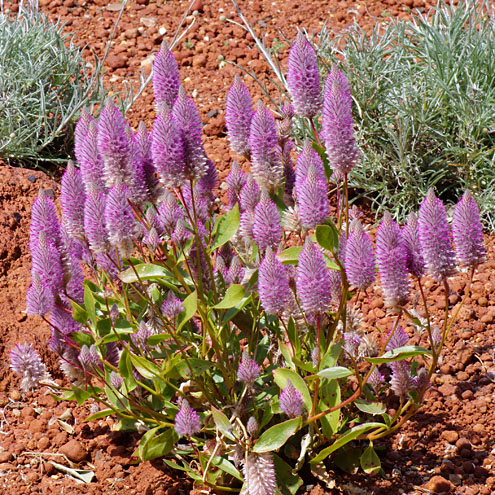
Quite apart from the economic factor that smaller plants cost less, it’s commonly advised to use small plants wherever possible. However, this is mainly because smaller plants are generally less likely to become “root bound” by being kept in a pot for an extended period. Smaller plants tend to suffer less “transplant shock” and are more likely to be be quicker to establish than larger plants when planted out.
Of course, another benefit of buying small plants or even tubestock is that you can buy more of them! This means that you can plant groups of plants together, which is how many plants grow in nature. You can even achieve a multi-trunked effect by planting three or four trees in the one planting hole.
In areas where rabbits are present, the use of plastic tree guards is advisable. A couple of rabbits can defoliate small plants in a couple of nights. Make sure the plastic is anchored into the ground securely. Tree guards will also help to minimize plants drying out during hot, windy weather.
However, you don’t need to discount the use of larger plants. If you can be sure that the root system of the plant has not developed into a tight mass in the pot or if you are prepared to carry out some root pruning before planting, there is no reason why larger plants can’t be used. However, the large root mass of advanced pot plants means that they can easily dry out during a few days of dry weather during the warmer months – make sure that watering is not neglected at such times.
A useful tip for both small and large plants when planting is to place a pot or tin (with holes punched in the bottom) into the planting hole next to the plant, making sure that the rim of the pot or tin is at, or just above, the final soil level. This allows hand watering so that water gets directed to the roots of the plants.
Some Australian plants tolerate pruning and some don’t but that’s true for plants from anywhere in the world. As a general rule all shrubby plants will tolerate light pruning to develop a bushy shape as they are growing. Pruning of mature plants can, however, present problems.
 |
| Callistemons usually respond well to severe pruning Photo: Brian Walters |
There are plants which can be pruned back to ground level and which will regenerate quickly by sending out masses of new growth…this is a technique sometimes referred to as “chain saw therapy”. Plants in this category include those which develop a lignotuber (a swelling at or below ground level from which new growth forms) such as many banksias, eucalypts, melaleucas and isopogons, to name just four. Others, including most callistemons and the popular Grevillea hybrids G.“Robyn Gordon”, G.”Honey Gem” and G.”Superb” also tolerate such treatment.
As an example, the Callistemon “Captain Cook” shown in the photo shows vigorous regrowth after being cut back to near ground level.
Callistemons (bottlebrushes) should generally be pruned after flowering with the exception of C.viminalis and its cultivars which have a weeping habit that can be damaged by pruning.
If in doubt, pruning back by about one third should not cause problems as long as there is plenty of green foliage remaining. Annual pruning directly after flowering is a sound rule to follow.
 |
| Tree Waratah (Alloxylon flammeum) Photo: Keith Townsend |
….usually only those native to dry areas and only when they have successfully negotiated the initial 12 months after planting out! Many young plants are lost during their first summer after planting out due to drying out.
It’s often claimed that Australian native plants have a lower requirement for artificial watering than plants from other countries. While this is possibly correct as a general statement, it’s only true because the majority of Australian plants that are readily available are those native to the drier forests and woodlands.
Australian native rainforest plants are becoming more readily available and it would be unreasonable to expect these to be drought resistant. Surprisingly, though, many of these will tolerate extended dry periods but they undoubtedly perform better when adequate water is available. One example of this is the tree waratah, a rainforest species native to tropical Queensland which grows and flowers quite well in much drier conditions.
No!
The term ‘protea’ is used to cover a range of related plants in addition to the genus Protea, including Leucospermum and Leucadendron. Despite the frequent appearance of these ‘proteas’ in so-called “native” flower arrangements, they are not Australian plants. They are native to South Africa.
The genus Protea has given its name to a family of related plants (the Proteaceae) and there are are a number of Australian members of this “Protea family”. These include Banksia, Grevillea, Hakea, Macadamia, Telopea (waratah) and many others.
No again.
These are small leaved plants (often called ‘heaths’) with small to large bell-shaped flowers and, like the proteas, they are also commonly included in “native” flower arrangements. But Australia has no native ericas although at least one species (E.lusitanica) has naturalised and become a weed in some districts. Ericas belong to the plant family Ericaceae.
Australia has a group of plants which are also often called ‘heaths’. These are species in the genera Epacris, Styphelia, Woolsia and several others. These are closely related to the exotic heaths. In the past these australian heaths have been classified into a separate family, the Epacridaceae, but most botanists now regard them as also being in the Ericaceae.
It depends on what you define as “Australian conditions”.
| What constitutes “typical” Australian conditions? | |
| HOT? | COLD? |
| HUMID? | ARID? |
| TROPICAL? | ALPINE? |
| WET? | DRY? |
| CLAY? | SAND? |
| FERTILE? | STERILE? |
| ACIDIC? | ALKALINE? |
The problem was more common some years ago when the cultivation of Australian plants native to all parts of the country was attempted in all other parts. This failed to recognise the fact that there are many climatic zones in Australia and that attempting to grow plants from one climatic zone in another was bound to lead to problems. While it was accepted that alpine plants would be difficult to cultivate in (say) arid areas, the effect of less obvious climatic differences was recognised mainly by bitter experience.
We now accept, for example, that plants native to areas of dry summers (such as south Western Australia) may be difficult to grow in gardens in areas of wet, humid summer conditions (such as the east coastal strip of New South Wales and Queensland). Having said that, there are many plants that adapt well to climates that are different to those of their natural habitat.
Another problem is that people tend to think of native plants as a single group, similar to Camellias, Roses or Azaleas. A visit to most general garden centres will reinforce this view, where you’ll see the ‘natives’ all grouped together despite the fact that they are a very diverse collection spread over many different genera and species and native to varying climatic zones. Native plants are available that are as long lived as any exotic but they need to be selected so that you grow those that are suited to your local climate and soils.
The best way to select long-lived plants for your conditions is to visit specialist native plant nurseries in your area. These specialists will also have plants unsuitable for long term growing (because there is a demand for these by enthusiasts who like a challenge). However, the specialist nurseries will also have the expertise to advise on reliable plants for local conditions. We have a list of specialist nurseries here.
 |
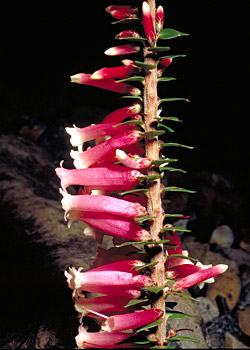 |
|
| Correa reflexa (left) and Epacris longiflora (right). Does either one really look like a fuchsia? Photos: Brian Walters |
||
We don’t “always” use botanical names but, you’re almost right. The problem is that the majority of Australian plants just don’t have accepted common names and, in many cases, common names that do exist can apply to two or more totally different plants.
For example, “Native Fuchsia” can apply to either Epacris longiflora or Correa reflexa, depending on whether you live in New South Wales or Victoria…and the two plants aren’t even closely related (except that they’re both plants!). To confuse the issue even further, Eremophila maculata is sometimes called “Native Fuchsia” also!
So botanical names are used to minimize confusion and, while there are a few “tongue-twisters”, most aren’t that difficult. Is it that much harder to pronounce “Melaleuca” than “Honey Myrtle”??
Well, as far as ornamental plants are concerned, a hybrid is usually a cultivar; but a cultivar doesn’t have to be a hybrid!
Now, is that perfectly clear?
 |
 |
| Top: Grevillea banksii Bottom: Grevillea ‘Superb’. Photos: Brian Walters |
OK, the word “cultivar” is short for “cultivated variety” and a cultivar is a selected form of a plant that has some desirable characteristic for cultivation. It is often given an attractive name by an enterprising horticulturist with the hope of commercial success. The desirable characteristic might be flower colour, growth habit, foliage characteristic, disease resistance or anything else. The Australian Cultivar Registration Authority provides a detailed definition of a cultivar but, in simple terms, a cultivar may be:
- an unusual form of a pure species that was discovered in the wild,
- a form that arose by chance in a batch of seedlings in a nursery, or
- a hybrid.
So a cultivar can be, but doesn’t have to be, a hybrid.
A hybrid is a genetic “cross” between two different species (usually within the same genus) or between a species and other hybrids. Hybrids can occur naturally or they can be produced by human intervention. The aim of deliberate hybridization is to produce plants with desirable characteristics. If the hybridization gives successful results, the plant is usually given a cultivar name and released commercially….so, a successful hybrid is also a cultivar.
As examples, Grevillea banksii is a pure species, Grevillea banksii “Ruby Red” is a cultivar selected for its prostrate habit and Grevillea “Superb” is a hybrid cultivar between G.bipinnatifida and G.banksii.
Most of the more commonly cultivated Australian plants occur naturally in nutrient deficient soils, often particularly low in phosphorus. This has led to the misconception that fertilizers should not be applied to them. However, to obtain optimum growth, all plants require the basic elements nitrogen (N), phosphorus (P) and potassium (K) in balanced proportions….it’s a question of “how much” and “how often”!
 |
| A cluster of proteoid roots Photo: Brian Walters |
General purpose fertilizers with an N:P:K composition of about 12:14:10 can be applied safely to many Australian plants, preferably in slow-release form so that the release of nutrients to the plants is gradual. However, the relatively high level of phosphorus in such fertilizers can be dangerous to phosphorus-sensitive plants. This is particularly true of many members of the Protea family such as Banksia, Grevillea, Telopea and Hakea. Most of these plants have developed specialised roots called “proteoid” roots which consist of a fine mass of many small “rootlets”. These are believed to enable the plants to take up nutrients from the nutrient-deficient soils and, if fertilized to excess, they may take up nutrients (particularly phosphorus) in toxic amounts.
There are low-phosphorus fertilizers available (N:P:K composition of about 10:3:6) which can be used on phosphorus-sensitive species. Further information on this topic is available in the article Phosphorus Needs of Australian Plants and this can be used as a guide to fertilizer application.
Fertilizer is probably best applied in spring, just prior to the active growing period. If plants are growing well, annual fertilizing may not be necessary. Avoid fertilizing just prior to winter, particularly in cold districts as this could stimulate soft growth which can be easily damaged by frost. Fertilizer should only be applied when the soil is wet and it should be well watered in.
All native and exotic plants will burn but some are more difficult to ignite than others and will, hopefully, slow down the advance of a fire. There are, however, a range of plants which present a greater risk.
There is not a lot of published data on fire retardant plants but, generally, the most fire retardant species have the following characteristics:
- Large, broad leaves having a high moisture content (e.g. rainforest plants) or a high salt content (e.g. saltbushes)
- Smooth non-fibrous bark
- A fairly dense growth habit
Plants which burn vigorously include:
- Those with a high content of volatile oil in their trunks, branches or leaves (e.g. melaleucas, bottlebrushes, tea-trees, boronias, mint bushes and eucalypts).
- Trees with bark that hangs down in ribbons
The following references provide further information, including some recommended species to use:
- Australian Native Plants For Fire Protection – compiled by Neil Marriott for the Australian Plants Society (Victoria)
- Australian Plants for Fire Prone Areas
- Fires, gardens and fire retardant plants – a bibliography – compiled by the National Botanic Gardens, Canberra
- Firewise home gardens – a brochure published by ACT Planning and Land Authority (PDF)
- The Ingnitability of Leaves of Australian Plants
Sewerage pipes are at greatest risk from the roots of plants because, unlike water pipes, they are unpressurised. Because of this, the roots of plants can quickly grow into the pipes if a crack or other fault occurs.
When planting, the aim should be to keep any medium to large trees well away from the pipelines. As a tree grows, its roots expand and thicken and this causes stresses within the soil. If a sewer pipe is in the vicinity, the stresses can cause compression or movement of the pipe, leading to cracks or broken joints. Once the integrity of the pipeline is broken, any plants, even grasses, can cause blockages.
All trees and many large shrubs are a potential risk to sewerage pipes so they should be planted at least 4 metres away from the pipe’s alignment. The trees and other plants listed below are common examples of species with particularly vigorous root systems and they should be at least 10 metres from underground pipes. Note, however, that the list is not comprehensive – for further information refer to the Fact Sheet published by Western Water, Victoria.
Know what’s underground before planting!!
Trees with very vigorous root systems
|
Botanical Name
|
Common Name
|
|---|---|
|
Acer negundo *
|
Box elder *
|
|
Allocasuarina and Casuarina species
|
She oaks, river oak, forest oak
|
|
Angophora species
|
Large species
|
|
Araucaria species
|
Hoop, bunya and Norfolk pines
|
|
Castanospermum australe
|
Black bean
|
|
Corymbia species
|
Large gum trees
|
|
Eucalyptus species
|
Large gum trees
|
|
Ficus species
|
Figs
|
|
Grevillea robusta
|
Silky oak
|
|
Jacaranda mimosaefolia *
|
Jacaranda *
|
|
Liquidambar styraciflua *
|
Liquidamber *
|
|
Lophostemon confertus
|
Brush box
|
|
Melaleuca quinquenervia
|
Broad-leaved paperbark
|
|
Melaleuca styphelioides
|
Prickly paperbark
|
|
Platanus acerifolia *
|
Plane tree *
|
|
Populus species *
|
Poplars *
|
|
Quercus species *
|
Oaks *
|
|
Salix species *
|
Willows *
|
|
Schinus molle *
|
Pepper tree *
|
|
Schefflera actinophylla
|
Umbrella tree
|
| * indicates an exotic species | |
For that matter, why did your “Captain Cook” bottlebrush (supposedly a low-growing form) reach 4 metres?
 |
| Corymbia ‘Summer Beauty’ Photo: Brian Walters |
Both of these questions have the same answer…they were grown from seed. To be sure that a plant will be genetically identical to its parent (i.e. to have red flowers or to retain a low habit of growth), it must be propagated vegetatively, usually by cuttings. Because of the genetic mix within seedlings, plants grown from seed will often show a significant variation from the parent. This is why named “cultivars” must never be propagated from seed.
In the case of the “Red Flowering Gum” (Corymbia ficifolia – syn. Eucalyptus ficifolia), propagation from cuttings is not practical so, unless the plant is grafted using a known red flowering clone as a scion, a purchaser can never be absolutely sure that the plant will have red flowers. Colours such as pink, orange and white (as well as red) are regularly seen in seed-grown plants.
Fortunately, grafted plants of Corymbia ficifolia and other Corymbia cultivars that use C.ficifolia in their parentage are now available commercially. They are not cheap but if you want a particular flower colour, such as the bright pink of Corymbia ‘Summer Beauty’, it’s the only way to be sure.
 |
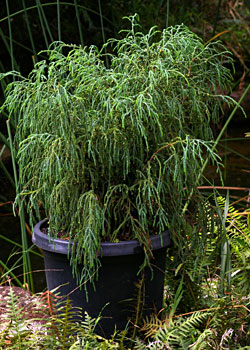 |
|
| Left: The Umbrella tree (Schefflera actinophylla); Right: Dwarf mountain pine (Pherosphaera fitzgeraldii) Both are both attractive foliage plants. Photos: Manuel Rodriguez and Brian Walters |
||
Most container-grown plants can be taken indoors for short periods (1-2 weeks) and can provide excellent decoration when in flower. As well, there are a number of Australian plants which can tolerate indoor conditions for extended periods. These are usually those species native to tropical and sub-tropical rainforests where the plants have become accustomed to low light levels. Some worth trying include Schefflera actinophylla (umbrella tree), Castanospermum australe (black bean), Davidsonia pruriens (Davidson’s plum), various Lilly Pillys (Syzygium species) and Grevillea robusta (silky oak). Cordyline species grow well indoors and in air conditioned areas. Although these are flowering plants, they are unlikely to flower if kept indoors for extended periods so selection should be based on their foliage characteristics.
Among the non-flowering plants, ferns make excellent indoor plants especially hardy ones such as Doodia aspera (rasp fern) and Nephrolepis cordifolia (fishbone fern). Even tree ferns (Dicksonia antarctica and Cyathea sp.) can be used for several years before their trunks develop. Cycads, such as Macrozamia communis (Burrawang) are also excellent indoors as is the small conifer Pherosphaera fitzgeraldii (syn. Microstrobos fitzgeraldii).
A good reference for choosing and maintaining Australian plants indoors is Growing Native Plants Indoors by John Wrigley and Murray Fagg, 1992 (published by Simon and Schuster).
 |
 |
| The Bell Miner (top) and Red Wattlebird (bottom) appreciate a variety of plants for cover and food Photos: Brian Walters |
Yes…this is because many grevilleas and banksias have flowers containing nectar which attracts honeyeating birds (so do lots of other plants by the way, including correas, eucalypts and callistemons). However, a garden comprised predominantly of these nectar-producing species may result in certain types of birds dominating (e.g. noisy miners, which actively discourage other, more timid species). To minimize this, it’s a good plan to choose plants that encourage a wide range of birds.
There are, of course, many other birds apart from honeyeaters and there are other reasons why birds might be attracted to a particular garden. To attract a variety of birds it’s a good idea to mix many different plants of different heights and growth habits so that shelter and nesting sites are available. For example, planting lots of small, bushy shrubs, including those with prickly foliage, will provide protection for smaller insect and seed eating birds, as well as for honeyeaters.
It should be remembered also that some birds are fruit eaters and many Australian plants, particularly those from the rainforest, will help attract these. And, don’t forget a bird bath – you’ll be surprised and entertained by the passing parade of bird species eager for a dip!
There are probably as many different potting mixes as there are propagators. With experience, most propagators develop their own variations to suit the conditions that they have available.
For seed raising and for striking cuttings it’s hard to go past the often recommended sand-peat moss mix in the ratio of about 7:3 as a starting point. These days many growers are turning to the artificial peat mosses which are becoming available and which are made from such waste products as coconut fibre. Experience so far indicates that the artificial products are capable of excellent results. The sand used should be clean and should have a high proportion of grains in the 1 to 3 mm range.
Once the seeds have germinated and the cuttings struck, the time will come for transplanting the small seedlings or cuttings into larger pots. For potting on, the mix should be of open texture so that it will drain freely. Potting mixes that have been used successfully include a coarse river sand/coco peat moss mix in the ratio of 3:2 and a mix of coarse river sand/coco peat moss/sandy loam in the ratio of 5:4:3.
If you make up your own mix, add some slow release ferilizer at the rate recommended on the pack. Most native plants don’t require any special fertilizer, however, some are sensitive to excess phosphorus and should be fertilized with special “native plant” fertilizers.
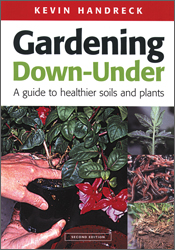 |
You can also purchase bagged “native plant mixes” from nurseries and garden centres. These usually come with fertilizer and trace elements already mixed through so there is no need to add additional fertilizer. Look for quality mixes manufactured to the specifications of Standards Australia.
A good reference on potting mixes generally is the CSIRO’s booklet simply titled Potting Mixes (No.9 in the “Discovering Soils” series). The principle in the CSIRO’s approach is to have a balance between water holding properties and air in the root zone of the plant. You can increase the amount of air in the mix by adding coarse material such as gravel (5-10 mm particles) or pine bark chips which have been stored and watered frequently for about six weeks to remove potentially toxic compounds.
A more thorough treatment of potting mixes can be found in Kevin Handreck’s book Gardening Down Under, also published by the CSIRO.
There are several hormones that are used to assist root formation on cuttings. The most common is Indole butyric acid (IBA) although Naphthalene acetic acid (NAA) is also used, sometimes in combination with IBA.

The products are usually available as powders in several strengths (softwood, medium wood and hardwood), but they can also be available as a gel or in liquid form. The ‘medium’ strength is recommended for most applications.
To use these chemicals, the lower centimetre or so of the cutting is dipped into the powder, liquid or gel before setting the cutting into the propagating mix – see accompanying image (Photo: Brian Walters).
It’s usually a good idea to pour out a small amount of the hormone into a small container – sufficient for the number or cuttings to be treated in the current session – to prevent possible contamination of the chemical remaining in the original container.
Do they work? Most experienced growers would say “yes”. The use of hormones often results in a stronger root system and may also produce earlier root formation. Many would also claim that the liquid formulations are superior to the other types but hard data is not readily obtained.
One fact to keep in mind whatever the formulation is that the hormones have a limited shelf life and should be kept in a cool, dark place when not being used (eg. a refrigerator).
 |
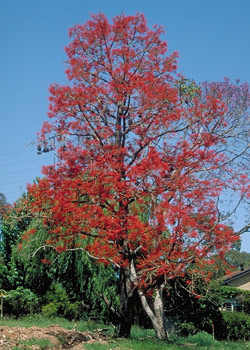 |
|
| Left: Melia azedarach in leafless mode. Right: Brachychiton acerifolius, leafless but in full flower Photos: Melia azedarach from Wikimedia Commons by Forrest and Kim Starr, reproduced under the Attribution 3.0 Unported License. Brachychiton acerifolius by Alfred Guhl |
||
Yes there are but comparatively few compared with the northern hemisphere. The majority are found in the tropical north of the continent. It may come as a surprise for those familiar with the forests of southern Australia to learn that many eucalypts of the tropical north are deciduous although not in winter and only for a short period before the wet season.
The two best known deciduous Australian species are the red cedar (Toona ciliata) and the white cedar (Melia azedarach). Both of these occur in subtropical rainforests of Queensland and New South Wales and are popular in cultivation. In Tasmania the deciduous beech (Nothofagus gunnii) can be found.
Some Australian trees can be partly deciduous in that they may lose foliage on a half or more of the tree just prior to flowering while retaining it on the other half. The Illawarra flame tree (Brachychiton acerifolius) is the best known example of this and it can sometimes be observed on the silky oak (Grevillea robusta).
Probably just sit back and enjoy it!
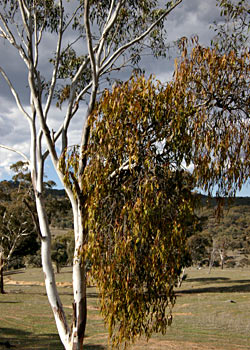 |
 |
|
| Left: A clump of mistletoe on a Eucalyptus sp. Right: The magnificent Western Australian Christmas Tree (Nuytsia floribunda) is a root parasite Photos: Brian Walters and Owen Roberts |
||
To clarify the situation for those unfamiliar with mistletoes, these are parasitic plants which attach themselves to other host plants (usually onto the branches, but root parasites are known) and extract most of their growth needs (water, nutrients) from the hosts. They can occur on almost any plant but are most commonly seen on eucalypts as ovoid-shaped clumps of foliage hanging from the tree’s branches.
Many mistletoes are host specific and their foliage may mimic that of the host tree.
Mistletoes and their hosts have evolved together and, unless the host tree is unhealthy, one or two (or more) mistletoe clumps should not cause any problems. In fact they can be enjoyed as part of the overall garden environment. They often have attractive fruit and flowers and, if you’re lucky, they will attract the beautiful mistletoe bird which lives almost exclusively on the fruit.
If mistletoes appear to be causing unacceptable stress on a tree, then it is usually a job for a professional tree surgeon.
For further information on mistletoes, see the excellent two-part article by Marion Jarratt published in Australian Plants online. Part 1 is here and Part 2 is here.
It depends on what you want to plant!!
There are many plants which are too big for even a large suburban garden but there are just as many which are ideal for smaller gardens, courtyards and containers. Even plants which are usually quite large are often available as small forms. Remember, too, that trees take up much less space at ground level than medium to large sized shrubs and are quite often the ideal plant for bordering a narrow driveway because the trunk may not exceed about 300mm in diameter.
Here are just a few examples of plants for smaller gardens:
Small eucalypts; Eucalyptus caesia (red/pink flrs), E.curtisii (massed cream flrs), E.forrestiana (red fruits/ yellow flrs), E.macrandra (yellow flrs), E.perriniana (decorative foliage), E.spathulata (bushy, narrow leaves), E.viridis (open habit).
Other smaller trees; Acacia fimbriata (weeping habit), Agonis flexuosa (weeping habit), Banksia cunninghamii, Callistemon viminalis (many forms), Callitris oblonga (conifer), Hakea salicifolia, Hymenosporum flavum (native frangipani), Pittosporum rhombifolium (orange berries), Tristaniopsis laurina (water gum).
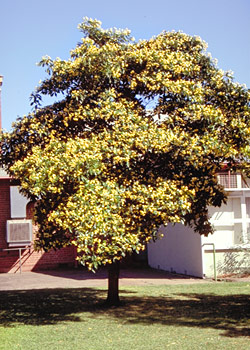 |
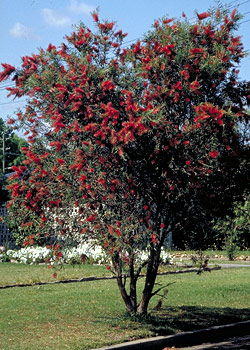 |
|
| Native frangipani, Hymenosporum flavum (left), and Callistemon viminalis (right), are both excellent small trees for the smaller garden Photos: Brian Walters |
||
Small to Medium shrubs; Acacia flexifolia, A.drummondii, Banksia brownii, B.paludosa, Callistemon citrinus (small forms), C.pinifolius (green brushes), Correa “Dusky Bells” (red flrs), Crowea “Poorinda Ecstasy” (pink flrs), Darwinia fasicularis (small red/white flrs), D.taxifolia (small red/white flrs), Grevillea sericea, Homoranthus flavescens (cream/yellow flrs), Melaleuca fulgens, M.huegelii, M.thymifolia.
Ground covers/clumps; Anigozanthos species and cultivars (“Kangaroo Paws”), Banksia blechnifolia (prostrate), B.integrifolia (prostrate form), B.repens (prostrate), B.serrata “Pygmy Possum” (low and spreading), Brachyscome cultivars (daisy-like), Callistemon comboynensis (prostrate form), Dianella species (blue flowers and berries), Hibbertia pedunculata (yellow “buttercup” flowers), Lomandra longifolia (grass-like clump), Patersonia species (flag lilies – blue).
Virtually all of the above will be suited to small or large containers. You can also grow a whole range of Australian ferns and orchids in containers as well as plants like Rhododendron lochiae, Tripladenia cunninghamii (bush lily) and Paphia meiniana (mountain bells).
Not all of the above will be suited to all climates and soils so, if you are unsure, make enquiries at your local Australian plant nursery or send us an email.
There are many more possibilities, but you get the idea……
A good question!!
It’s not easy but it can be done. You will need to be persistent because plants growing in shade where water stress is likely to be a problem are often more open in habit than if they were growing in a more favourable position. There are two main considerations:
- A reliable water supply
- Choice of appropriate plants
As a guide, consider the following suggestions:
- Resist the temptation to build up a garden bed in the root zone of the trees. To be effective the bed would need to be built up by about 400 to 500 mm and this may have long term detrimental effects on the mature trees.
- Plant the garden in autumn (the earlier the better) to give plants the longest possible period before the next summer. This also coincides with the period of least root activity by the trees.
- Dig holes for each plant at least twice the diameter and twice the depth of the root balls.
- Saturate the hole 2-3 times and allow the water to drain away.
- Mix some slow release fertiliser (at the recommended rate) with the soil when planting. Take care to use low phosphorus formula if phosphorus sensitive plants, eg. banksias, are to be used.
- Apply a dressing of Multigro (N:P:K 10:3:6) in early spring and again in late summer, making sure that the soil is wet when applied and water in well after application.
- Set a pot or tin (with holes punched in the bottom) into the planting hole next to the plant, making sure that the rim of the pot or tin is at, or just above, the final soil level. This allows hand watering so that water gets directed to the roots of the plants.
- Plant a couple of “indicator plants” which show early signs of water stress. These can let you know when watering is needed for the garden as a whole. For example many Prostanthera species (mint bushes) wilt markedly when stressed but recover quickly when watered.
- If possible install drip irrigation to each plant (into the pot or tin) so that water can be delivered at regular intervals either automatically (via a timer system) or manually.
- Choose plants which tolerate some shade and dryness and which are suited to your climate. Plants such as commonly available grevilleas are probably not ideal but some of the smaller banksias would be worth trying. You can find lists in references such as Grow What Where by the Australian Plant Study Group and The Encyclopaedia of Australian Plants – Vol 1 by Elliot and Jones. You will also find helpful advice in Australian Native Plants by Wrigley and Fagg.
- Finally, the use of a good thick mulch would be advantageous.
 Australian Native Plants Society (Australia)
Australian Native Plants Society (Australia)